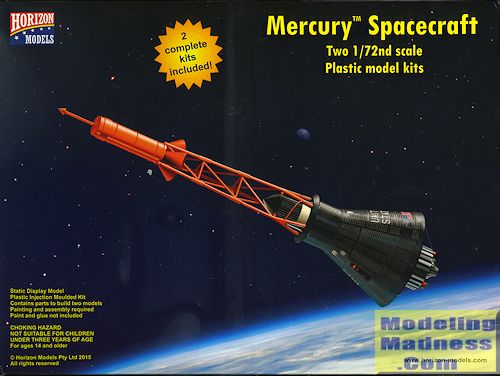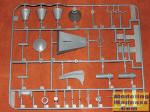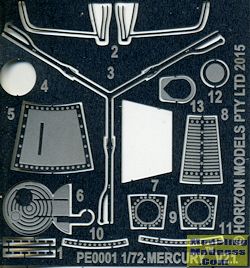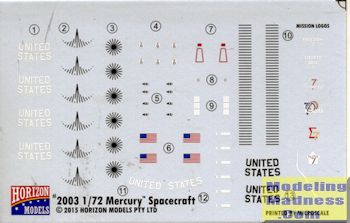
Horizon Models 1/72 Mercury Spacecraft
| KIT #: | 2003 |
| PRICE: | $24.95 SRP |
| DECALS: | Six manned mission options plus |
| REVIEWER: | Scott Van Aken |
| NOTES: | New tool, 2 complete kits, photo etch |

| HISTORY |
Project Mercury was the first human spaceflight program of the United States running from 1959 through 1963. An early highlight of the Space Race, its goal was to put a human into Earth orbit and return the person safely, ideally before the Soviet Union. Taken over from the U.S. Air Force by the newly created civilian space agency NASA, it spanned twenty unmanned developmental missions involving test animals, and successful missions completed by six of the seven Mercury astronauts.
The program took its name from the wing-footed, fleet god of travel in Roman mythology, and is estimated to have cost $1.73 billion (current prices) and to have involved the work of 2 million people. The astronauts were collectively known as the "Mercury Seven", and each spacecraft was given a name ending with a "7" by its pilot.
After a slow start riddled with humiliating mistakes, the Mercury Project gained popularity, its missions followed by millions on radio and TV around the world. Its success laid the groundwork for Project Gemini, which carried two astronauts in each capsule and perfected space docking maneuvers essential for lunar travel, and the subsequent Apollo Moon-landing program announced a few weeks after the first manned Mercury flight.
| THE KIT |
 First thing you notice is that you get two full kits in the box. You also get two sets of photo etch and enough decals to do any of the Mercury spacecraft, including the 'boilerplate' versions that were used in tests.
First thing you notice is that you get two full kits in the box. You also get two sets of photo etch and enough decals to do any of the Mercury spacecraft, including the 'boilerplate' versions that were used in tests.
Each kit is on a single large sprue that includes not only a display stand but also the body of the 'boiler plate' version. Each capsule is built up around a central core section that mounts onto the heat shield. There are three 'fuselage' sections that are attached.
There is a launch tower made of three support pieces that are glued together and atop that is a five piece rocket pack that consists of two halves and three nozzles. A spike fits atop that.
 The kit can be displayed in two different modes. One is the launch mode with the escape tower attached. Another is while it is in orbit or reentry. There is a single casting retrorocket pack that fits to the underside of the heat shield. A nicely done photo etch fret is included that includes the wiring for the escape tower, the straps for the retro rocket, the round windows for the early Mercury launches, some capsule braces for the early launches, a nose cap for the orbital and re-entry versions. and other smaller bits. There are empty spaces in the fret that are for bits that are not required for the builds.
The kit can be displayed in two different modes. One is the launch mode with the escape tower attached. Another is while it is in orbit or reentry. There is a single casting retrorocket pack that fits to the underside of the heat shield. A nicely done photo etch fret is included that includes the wiring for the escape tower, the straps for the retro rocket, the round windows for the early Mercury launches, some capsule braces for the early launches, a nose cap for the orbital and re-entry versions. and other smaller bits. There are empty spaces in the fret that are for bits that are not required for the builds.
 Instructions are nicely printed and are located on the back of the box. You can also download a .pdf version to print out from their web site if you so desire. These instructions cover all the differences between the different spacecraft so you can be sure you are modeling your favorite correctly. All the manned craft are painted a metallic blue-black while the boilerplate capsules are considerably more colorful. There is a single decal sheet that has all the markings you need for any of your chosen options, including the names put on all six manned missions. Note that I have darkened the sheet so that the white stands out a bit more.
Instructions are nicely printed and are located on the back of the box. You can also download a .pdf version to print out from their web site if you so desire. These instructions cover all the differences between the different spacecraft so you can be sure you are modeling your favorite correctly. All the manned craft are painted a metallic blue-black while the boilerplate capsules are considerably more colorful. There is a single decal sheet that has all the markings you need for any of your chosen options, including the names put on all six manned missions. Note that I have darkened the sheet so that the white stands out a bit more.
| CONCLUSIONS |
If you are a real space modeler and especially if you concentrate your efforts on manned missions, then this is a kit you should get. They are small enough not to take up a ton of space on your shelf and yet can be properly detailed. Those who bought and built the Dragon Mercury-Redstone kit and were disappointed by the capsule can now replace it with one of these.
| REFERENCES |
https://en.wikipedia.org/wiki/Project_Mercury
Copyright ModelingMadness.com October 2015
Thanks to Horizon Models for the preview kit. You can get yours direct fromthis link.
If you would like your product reviewed fairly and fairly quickly, please contactthe editor or see other details in the